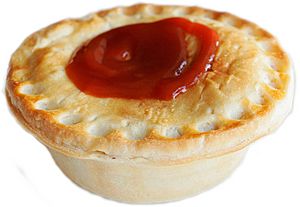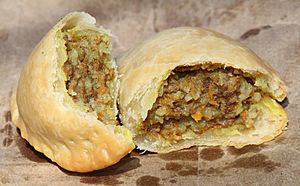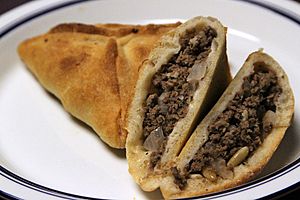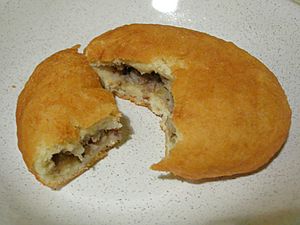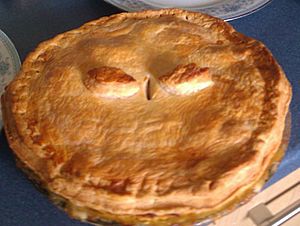Meat pie facts for kids
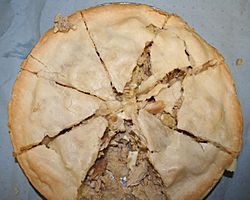
Chicken and rabbit meat pie
|
|
| Type | Savory pie |
|---|---|
| Main ingredients | Meat, pastry |
A meat pie is a tasty dish. It has a filling of meat and other savory ingredients. You can find meat pies in many different countries around the world.
Meat pies are usually baked, fried, or deep fried. This helps them turn golden brown and taste even better. Many types of meat pies have a light and flaky crust.
Contents
The Amazing History of Meat Pies
The idea of a meat pie is super old! It goes all the way back to the Stone Age, about 9,500 years ago. Pictures of early pies have been found on ancient Egyptian tomb walls. People in ancient Greece and Rome also wrote about them.
Pies in Ancient Times
The ancient Egyptians made simple pies. They used grains like oat, wheat, rye, and barley. These pies were filled with honey and cooked over hot coals.
The Greeks used a dough made from flour and water. They filled it with meat. These early pies were often fried or cooked under hot coals. The Romans learned from the Greeks. They used different meats, seafood, and fish as fillings. Their crust was made from flour, oil, and water. This crust was not meant to be eaten; it was just a container.
Pies in the Middle Ages
In Northern Europe, cooks made a strong dough with lard and butter. This dough could hold a pie upright. These medieval pies were called "coffins." They were like tall, straight-sided boxes with sealed bottoms and lids.
These pie crusts were often very thick. They had to be strong enough to bake for many hours. Some people think the tough crust was given to servants. The lords and ladies would eat only the delicious filling.
This type of pastry became very common in medieval times. By the 14th century, it was called a "pye" or "pie." The famous writer Geoffrey Chaucer even wrote about a cook who could "bake a pye." No one is quite sure where the word "pie" comes from. It might be linked to the magpie bird. Maybe because both were spotted, or because the bird collects many things, just like a pie can have many fillings!
Modern Pies and Their Journey
The French and Italians made pie pastry even better. They learned new ways to add butter and roll the dough. This made the crust flakier and tastier. In 1440, a pastry group in Paris was officially recognized. This helped the modern pie crust become popular.
Explorers and missionaries helped spread meat pies around the world. The English Pilgrims brought pie recipes to North America. The pie crust was great for keeping food fresh during long winters. However, sweet pies became more popular than meat pies in America by the 1800s.
Meat Pies Around the World
Meat pies are enjoyed in many different ways across the globe. Each region has its own special twist!
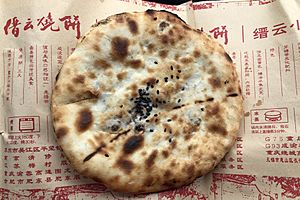
North America
The Natchitoches meat pie is so special in Louisiana, USA, that it's one of the state's official foods!
Africa
The Nigerian meat pie is a bit like the Jamaican beef patty. It can be baked or fried. Fillings often include minced beef, potatoes, and carrots. Sometimes it's just onions and tomatoes.
Latin America
Latin American meat empanadas are very popular. They can be pies or pasties. They use different pastry shells and fillings. Empanadas can be baked or fried. They often have lots of onion and green or red pepper with meat or fish. The dough can be made from cornmeal or puff pastry. Fillings vary widely. You might find ground beef with olives, fried egg, pulled pork, or even cheese and salami. These are popular in countries like Chile, Argentina, and Peru.
Australia and Europe
In Australia, the meat pie is a very common convenience food. You can find it everywhere, from gas stations to pubs and supermarkets. An Australian version of the Irish steak and Guinness pie is also popular. It has round steak, Guinness Stout Beer, bacon, and onions. It's often served with potato chips and vegetables in Irish pubs.
In Turkmenistan, a meat pie is called ishlekli. It's also known as a shepherd's pie. Shepherds traditionally baked ishlekli by burying it in the hot sand and coals of the Turkmen desert. Today, it's usually baked in an oven. But some shepherds still use the old method!
Middle East and Asia
Middle Eastern meat pies are called sfiha. They contain ground beef, olive oil, yogurt, tahini, and pine nuts. Greek meat pies are called kreatopita. They have ground beef, onions, and feta cheese. The filling is wrapped in thin phyllo dough. Indian meat pies are called samosa. They usually have peas, spiced potatoes, or ground beef or chicken. They are often served with a sauce called chutney.
Chinese meat pies have several types. One famous one is the Xianghe meat pie.


